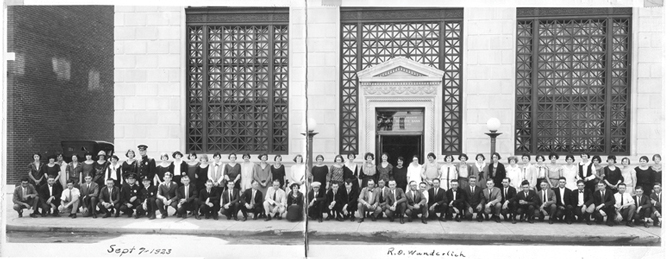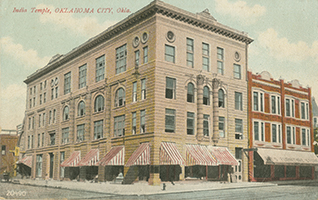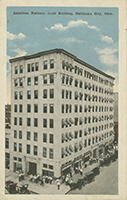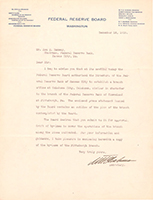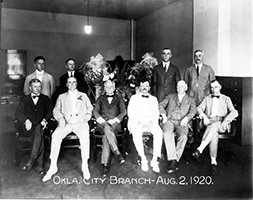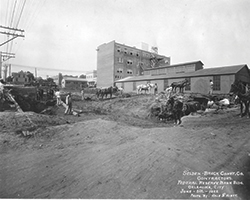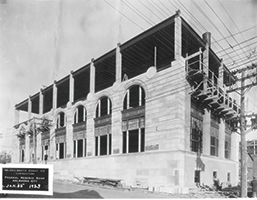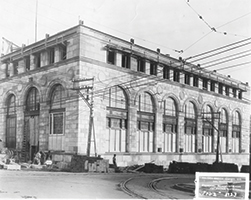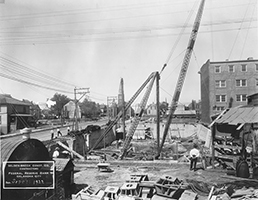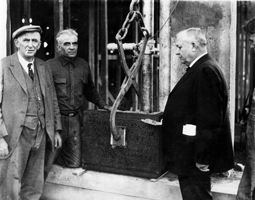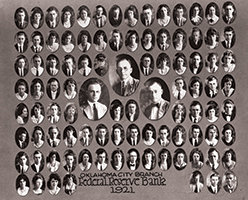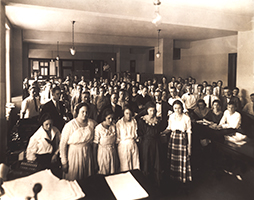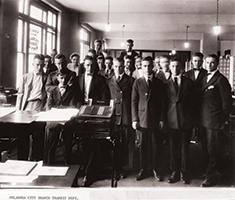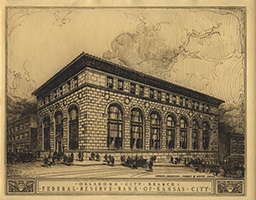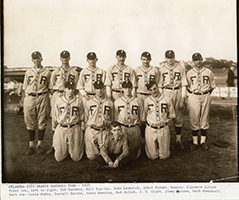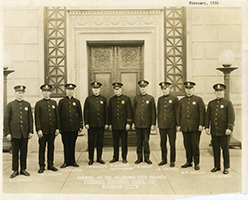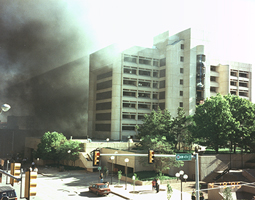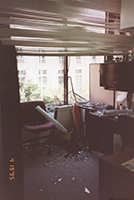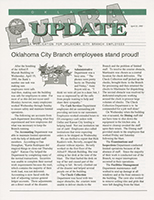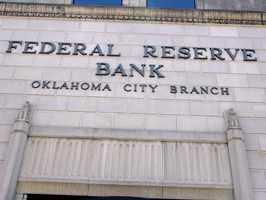History of the Oklahoma City Branch
The Oklahoma City Branch is located in downtown Oklahoma City with approximately 40 employees focused on economic research, public outreach and community affairs, as well as bank examination and financial services.
When the original boundaries were drawn in the Tenth District, eight counties in southeastern Oklahoma were placed in the Eleventh District. Financial institutions in this area of the state were interviewed as to where they do most of their business. Naturally, they said Texas because it was much easier to get there than to Oklahoma City. These counties remained in the Eleventh District until 1984, when the financial institutions in these counties petitioned the Board of Governors to redraw the boundaries. It was granted, and in 1984, the boundaries were redrawn to include all of Oklahoma in the Tenth District.
The Branch officially opened for business on August 2, 1920. The original office was the entire second floor of the Continental Building, at the corner of Second and Broadway. The original staff consisted of 50 employees and their activities were primarily the collection of checks and the issuance and redemption of United States Currency. By the end of the first month, the Branch had exceeded all expectations. More than 969,500 checks were processed for a total of $189 million. In comparison, in 1992, an average of 18 million checks were processed each month for a total of $10.8 billion. The growth of the bank continued and the original staff of 50 was increased to 100. It became necessary to obtain additional space for the operations of the Money Department by renting vaults and working space in the basement of the American National Bank. The Branch also accepted applications for loans and rediscounts from its member banks, and these were processed through the Kansas City office.
A New Home
Because of the Branch’s growth, approval was given in October 1921, to construct a new building located at the corner of Harvey and Third Street. At that time, the location seemed to be a considerable distance from the downtown business section, but it was necessary to have the Branch located close to the Post Office. During the 1920s, the Branch also served as custodian for the War Finance Corporation, thus requiring frequent usage of the Post Office. Purchase price of the property was $65,000. Construction didn't actually begin until May, 1922, with an estimated cost of $450,000.
The cornerstone of the new Branch was laid on December 7, 1922, by W. J. Bailey, Governor, Federal Reserve Bank of Kansas City (at that time, presidents of Reserve Banks were known as governors). A trowel, presented by the Oklahoma City Clearing House Association, was used to lay the corner-stone. Small quantities of minerals and agricultural products, representing the resources of Oklahoma, were placed in the cornerstone, as were copies of The Daily Oklahoman and the Oklahoma City Times.
The Central Oklahoma Clearing House Association (COCHA) was an organization whose members are financial institutions in the metropolitan Oklahoma City area. Representatives from these institutions met in the clearing house room twice daily to trade checks drawn on other institutions within the group. The independent association is not affiliated with the Federal Reserve System. The Fed simply provided a central place for clearing house members to meet to exchange checks at noon, and again in the evening to exchange returned checks. This direct exchange of local checks sped up the check clearing process.
On May 1, 1923, the Branch moved into that building. The branch had 40 employees and 4 officers.
The Vault
The 100,000 lb. vault door was reported to be the largest west of New York. The Oklahoma City Branch had the thickest vault door (100,000 lbs.) west of the Mississippi, according to the company who installed it. Divided into compartments, the vault was 21’ by 42’ inside and 12’ high at 247,000 lbs. The mass of steel arrived on a train flatcar. To get it to the building’s construction site several blocks away, it had to be moved on a steel truck that was pushed along with hydraulic jacks. It was literally a traffic stopper and could be moved only a few feet per day, as it took one to two hours to move five inches. Only government officials were used, for fear that a crook might try to slip in and get measurements. The moving of the vault was the largest moving job attempted in Oklahoma City at the time. The vault took 90 days to assemble and install.
Although the door was extremely heavy, it was perfectly balanced and could easily be closed with one hand. At night, the bottom portion of the floor was lowered approximately one foot, and the door would swing shut. There was no room for clearance between the door and the frame, and a single sheet of paper would keep the door from closing. One night a Bank officer was having trouble closing the door, and much time was spent trying to figure out what was keeping it from closing. The door was reopened and, during an inspection, a paper clip was found on top of the door, preventing it from closing. The paper clip made a permanent indention and it was pointed out on branch tours.
The vault had a four-foot dead space between the floor of the vault and the ground (every Federal Reserve vault built in the early days had such a space somewhere around the vault). The purpose of this space was to allow the guard to patrol around the vault, making sure no one was trying to tunnel through the floor. The vault operated on three time locks, one was always preset. The door also had three sets of combination locks, each set requiring two employees to open them.
The new facility continued to accommodate the needs of the Branch until March 1958, when the property adjacent to the original building was purchased for $500,000, and expanded to meet the operational demands of the Branch. This was the beginning of a $2 million expansion project of the original building. Construction didn’t actually begin until August 1960, and would include a new vault, cafeteria and parking facilities. The expansion project also included the remodeling of the original structure. The project added 48,000 square feet to the old building’s 39,000 square feet. The old vault was left intact, but an even larger vault was added across a corridor from the old one. The new vault had four time locks and four sets of combination locks and the door weighed 88,000 pounds. In December 1962, the expansion project was completed and a special tour was given to several hundred Oklahoma bankers.
The new facilities continued to serve the bank until 1976, when a $2 million renovation project was approved. This project involved the consolidation of coin and currency operations and the relocation of the Securities Department. It also involved the expansion of Data Processing and Check Collection, as well as providing additional protection and security features. A coin vault was installed in 1977. All coin deposits from and shipments to financial institutions were processed in this vault.
Financial Crisis & Flooding
Kas Stewart, Fed retiree, remembers the Penn Square Banking Crisis. She said the on The Fourth of July weekend of 1982 Oklahoma began going through a banking crisis. Banks turned to the Fed for support and lending. The Fed helped small rural banks to The First National Bank of Oklahoma City.
From 1982-1990, 113 banks closed in Oklahoma.
On Dec. 25, 1983, sub-zero temperatures caused a main water valve to break at the Oklahoma City Branch flooding the vaults in the basement. Time locks on the vaults prevented access to the vaults until the Tuesday after Christmas, at which time water poured out of the vaults when they were finally opened. Mike Dunning, a former facilities employee from 1985-2006, said, “When the vaults flooded in 1983, there was 18 inches of water in three of the four vaults. The vault that had not flooded was the original vault from 1921.”
Kas Stewart, an employee from 1973-2005, said the ledger books, minutes for monthly board meetings and the daily records of what happened at the discount window were stored in the vaults. When the vaults flooded these records were soaked. Kas said she remembers, “laying the documents out on different surfaces in departments all over the Branch in hopes that some information could be saved.”
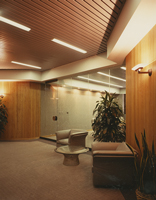
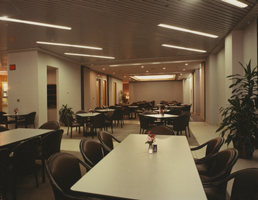
In 1986, a $1.5 million facelift of the building was approved. This project focused on improving the energy efficiency of the building and reorganizing the office space on the third floor. A new cafeteria and executive dining facility were results of this remodeling project. This renovation carried the Branch through 1991, when a study was conducted on whether to build a new facility or renovate the existing building. A decision was made to renovate the interior of the existing building and preserve the historical exterior in the process. This $10 million renovation project was completed in several phases, remodeling one floor at a time. The project began with departmental interviews in late 1991, to determine the needs of each area. Architectural designs were completed in 1993, and actual construction on the project began in early 1994. The final portion of the renovation project was completed in 1997.
On November 16, 1989, a panel from the adjacent Bank of Oklahoma building falls onto the roof of the Oklahoma City Branch building, demolishing the cooling tower and placing the air conditioning out of commission. Mike Dunning, a former facilities employee from 1985-2006, said When the panel fell it broke a hole in the roof. Large amounts of water from the cooling tower fell onto the second and third floor. Both floors flooded. The areas most affected were the cafeteria and Check Department. The kitchen in the cafeteria did not get damaged. However, no one could eat in the flooded cafeteria so they ate lunch on tables in the hallways. The Check Department had two large sorting machines that were kept under particular climate controls. With the air conditioning out they had to be moved to another area. Luckily, the machines were not ruined. Mike said he remembers parts of the building being without air conditioning for close to six months. He said it was days before he was even able to go to the roof to check out the damage. He and the other facilities team were too busy cleaning up the messes caused by the panel.
The Oklahoma City Bombing
On April 19, 1995, the Fed building and its employees were affected by the large bomb that decimated the Alfred P. Murrah Federal Building. Mike Dunning, a former facilities employee from 1985-2006, said at the time of the bombing, renovations were taking place at the Oklahoma City Branch. Mike said he remembers that there were contractors working outside high up on scaffolding when the blasts went off. They were not secured and almost fell. He said he was in the basement on a break when the blasts went off. Mike remembers running to the basement garage door and looking out. All he could see was dirt and debris flying around everywhere. By the time all the men had rushed to the ground floor the windows had all been busted out. Mike said, “It was just raining glass outside.” Both of the front doors had blown out, as well. He said Bank management had everyone evacuate to the Myriad Gardens. Everyone present was asked to stay at the gardens until further notice. Mike said he, and the rest of the maintenance men, started edging their way back towards the bank since they knew they needed to start cleaning and boarding up windows. They began cleaning glass and debris but the FBI made them stop in fear that they were tampering with evidence. Lori Zuchnik, employee with 25+ years of service in various positions throughout the Bank, said employees at work that day had to coordinate to have someone pick them up since no one could access their vehicles at the offsite parking lot. Some employees tried to come to work the next day, but no one was allowed in the building since the “Protection Department was having to coordinate with the FBI and could not resume operations until a few items of business were settled.”
In 1999, the Oklahoma City Branch won the Oklahoma Quality Award. Fed retiree, Kas Stewart, said there was a committee of 12 employees working on the Oklahoma Quality Award application. “This committee worked very hard to win the award,” she said. Kas said she served on the committee and remembers meeting on the weekends to edit each other’s writing and work on the application.
Security Measures
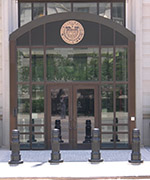 In 2003, following the 2001 terrorist attacks in New York and Washington, D.C. Planters and Bollards are installed in front of the branch. The bollards are steel pipes laid in concrete eight feet deep into the ground. Lori Zuchnik, employee with 25+ years of service in various positions throughout the Bank, said the planters out front are not for decoration. The large planters surrounding the building are full of heavy dense rebar. This is a security measure that would keep a vehicle from driving into the building.
In 2003, following the 2001 terrorist attacks in New York and Washington, D.C. Planters and Bollards are installed in front of the branch. The bollards are steel pipes laid in concrete eight feet deep into the ground. Lori Zuchnik, employee with 25+ years of service in various positions throughout the Bank, said the planters out front are not for decoration. The large planters surrounding the building are full of heavy dense rebar. This is a security measure that would keep a vehicle from driving into the building.
Changes & Honors
In 2004, the Oklahoma City Branch was awarded the Perfect Partnership Award from the Oklahoma City Public Schools Foundation for the work employees did with its Partners in Education school, Dunbar Elementary. Linda Roberts, 1998-2013, said she remembers going to read to the children at Dunbar Elementary School. She read to the same student once a week for five years.
In December 2005, The Federal Reserve System announces that cash services provided to financial institutions by the Oklahoma City Branch of the Kansas City Federal Reserve Bank will transition to a cash depot arrangement with service provided by the Dallas Federal Reserve Bank. The Branch said farewell to 44 employees who had served the bank for a collective 791 years, with an average individual tenure of 16 years. Employees were given opportunities to participate in several benefits education and career transition activities, including resume writing and interviewing skills workshops.
In 2006, the new Oklahoma City Branch model was established, along with the Regional Affairs Department that provides economic analysis, conducts economic research and leads regional monetary policy communications. By the end of 2006, the Cash, Protection, Check and Facilities departments had all been dissolved from the branch leaving approximately 35 employees.
On August 14, 2007, the Oklahoma City Branch celebrates the opening of the newly renovated branch building with a ribbon cutting and open house. All branch departments are now located on the third floor. The facility is approximately 22,000 square feet and houses an exhibit space and conference facility.
Although the building was sold in 2006, Oklahoma City Branch employees are still housed in the historic Fed building in the heart of downtown Oklahoma City on the third floor in leased space.
For more than 90 years, the Branch has been the Federal Reserve’s conduit to the Oklahoma business community and an integral part of the Federal Reserve Bank of Kansas City’s work. As part of the nation’s central bank, the Bank participates in setting national monetary policy, supervising and regulating numerous commercial banks and bank holding companies, and providing financial services to depository institutions. Additionally, the Oklahoma City Branch is focused on educating the community on economic and financial issues.
Protecting the Federal Reserve
Prior to selling the Oklahoma City Branch in 2006, employees in the Protection Department were responsible for protecting all Bank property, assets, and employees from injury, loss or damage from fire, accidents, theft, natural disaster or criminal activity. These important responsibilities are performed by a highly trained professional guard force. All of the guards were experts with weapons before coming to work at the Fed (i.e., former police, military, or weapons expert), and had to qualify on the Fed’s firing range to be hired. All of the guards carried a .357 magnum revolver. The Oklahoma City Branch had a firing range inside the building and each guard has to qualify monthly on the firing range with their revolver, and quarterly with a shotgun. The guards practiced shooting under various conditions:
- subdued lighting that simulates night conditions,
- from behind barriers,
- from varying distances with their strong hand and again with their weak hand, and
- from a standing position with their gun holstered.
The guards stayed on their post for a minimum of 45 minutes and a maximum of one hour. They continually changed posts to enhance their alertness. Protection officers were on post 24 hours a day, 365 days a year.

